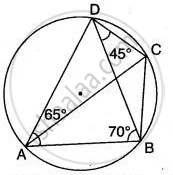Advertisements
Advertisements
प्रश्न
In the given figure, AB is the diameter of a circle with centre O.
∠BCD = 130°. Find:
- ∠DAB
- ∠DBA
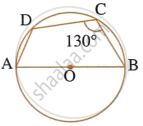
उत्तर
i. ∠DAB + ∠BCD = 180° ...(Opposite angle of a cyclic quadrilateral)
∠DAB + 130° = 180°
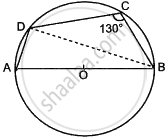
∠DAB = 180° – 130°
∠DAB = 50°
ii. ∠ADB = 90° ...(Angle in semicircle)
In ΔADB,
∠DAB + ∠ADB + ∠DBA = 180° ...(Angle sum property)
50° + 90° + ∠DBA = 180°
∠DBA = 180° – 140°
∠DBA = 40°
APPEARS IN
संबंधित प्रश्न
In the given figure, AB is the diameter of a circle with centre O. ∠BCD = 130o. Find:
1) ∠DAB
2) ∠DBA
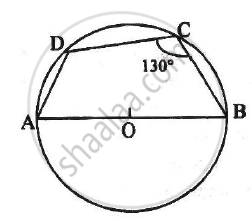
In the given figure, AB = AC. Prove that DECB is an isosceles trapezium.

In cyclic quadrilateral ABCD, ∠A = 3∠C and ∠D = 5∠B. Find the measure of each angle of the quadrilateral.
In a cyclic-quadrilateral PQRS, angle PQR = 135°. Sides SP and RQ produced meet at point A whereas sides PQ and SR produced meet at point B. If ∠A : ∠B = 2 : 1; find angles A and B.
In the figure, given below, find: ∠ABC. Show steps of your working.

In cyclic quadrilateral ABCD, ∠DAC = 27°; ∠DBA = 50° and ∠ADB = 33°. Calculate : ∠DCB.
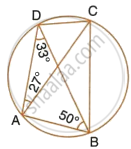
In the following figure, Prove that AD is parallel to FE.

ABCD is a parallelogram. A circle through vertices A and B meets side BC at point P and side AD at point Q. Show that quadrilateral PCDQ is cyclic.
In the figure, ∠DBC = 58°. BD is a diameter of the circle. Calculate : ∠BEC
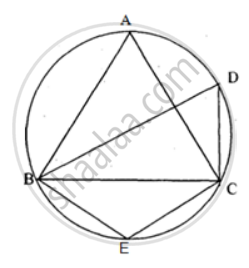
In the given below figure,
∠ BAD = 65°
∠ ABD = 70°
∠ BDC = 45°
Find: (i) ∠ BCD, (ii) ∠ ADB.
Hence show that AC is a diameter.